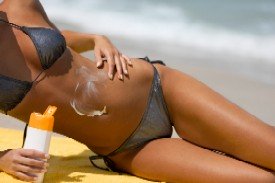Sun Protection Cream Spf 50
Sun Protection is a fact of life™
Sun protection cream SPF 50 is a type of sunscreen that blocks 98% of the sun's harmful ultraviolet (UV) rays. UV rays can cause skin damage, premature aging, and skin cancer. Sun protection cream SPF 50 is recommended for people who have fair skin, live in sunny areas, or spend a lot of time outdoors.

In this article, we will explain what sun protection cream SPF 50 is, how it works, how to use it, and what are its benefits and drawbacks.
What is sun protection cream SPF 50?
Sun protection cream SPF 50 is a sunscreen product that has a sun protection factor (SPF) of 50. SPF is a measure of how well a sunscreen protects against UVB rays, which are the main cause of sunburn and skin cancer. The higher the SPF, the more protection it offers.
SPF 50 means that the sunscreen can filter out 98% of the UVB rays. This means that if you would normally get sunburned in 10 minutes without sunscreen, you can stay in the sun for 500 minutes (10 x 50) with SPF 50 sunscreen before getting sunburned. However, this does not mean that you can stay in the sun for that long without reapplying the sunscreen or taking other precautions.
Sun protection cream SPF 50 also protects against UVA rays, which are the main cause of skin aging and wrinkles. UVA rays can penetrate deeper into the skin and damage the collagen and elastin fibers that keep the skin firm and elastic. UVA rays can also cause skin discoloration, such as age spots and melasma.

To protect against both UVA and UVB rays, sun protection cream SPF 50 should have broad-spectrum coverage. This means that it meets the standards set by the U.S. Food and Drug Administration (FDA) or other regulatory agencies for providing adequate protection against both types of rays.
How does sun protection cream SPF 50 work?
Sun protection cream SPF 50 works by creating a thin layer on the skin that reflects or absorbs the UV rays before they can reach the skin cells. Sun protection cream SPF 50 can contain either chemical or physical ingredients, or a combination of both.
Chemical ingredients are organic compounds that absorb UV rays and convert them into heat. Some common chemical ingredients are avobenzone, oxybenzone, octinoxate, octisalate, octocrylene, and homosalate.
Physical ingredients are mineral particles that reflect UV rays away from the skin. Some common physical ingredients are zinc oxide and titanium dioxide.
Some sun protection creams SPF 50 may also contain antioxidants, such as vitamin E, vitamin C, green tea extract, or grape seed extract. Antioxidants help to neutralize free radicals, which are unstable molecules that can damage the skin cells and cause inflammation and aging.
How to use sun protection cream SPF 50?
To use sun protection cream SPF 50 effectively, you should follow these steps:
- Apply sun protection cream SPF 50 generously and evenly to all exposed areas of the skin at least 15 minutes before going out in the sun. Use about one ounce (30 ml) of sunscreen for your whole body, or about a teaspoon (5 ml) for your face.
- Reapply sun protection cream SPF 50 every two hours or more often if you sweat, swim, or towel dry your skin.
- Avoid exposure to the sun between 10 a.m. and 4 p.m., when the UV rays are strongest.
- Wear protective clothing, such as hats, sunglasses, long sleeves, and pants, to cover your skin as much as possible.
- Seek shade whenever possible.
- Check the expiration date of your sun protection cream SPF 50 and discard it if it is past its shelf life.
What are the benefits and drawbacks of sun protection cream SPF 50?
The benefits of sun protection cream SPF 50 are:
- It provides high-level protection against both UVA and UVB rays.
- It reduces the risk of sunburn, skin damage, premature aging, and skin cancer.
- It may prevent or fade some types of skin discoloration caused by sun exposure.
- It may moisturize and nourish your skin with antioxidants and other ingredients.
The drawbacks of sun protection cream SPF 50:
Sun protection cream SPF 50 is a popular product that claims to protect your skin from the harmful effects of the sun's ultraviolet (UV) rays. But is it really as effective and safe as it sounds? In this article, we will explore some of the drawbacks of using sun protection cream SPF 50 and why you might want to reconsider your choice.
One of the main drawbacks of sun protection cream SPF 50 is that it does not provide adequate protection from UVA rays, which are more closely linked to skin aging and cancer than UVB rays, which cause sunburns. SPF stands for sun protection factor, and it measures how well a product can block UVB rays, but not UVA rays. According to a study by EWG, most sunscreens in the U.S. provide only half of the UVA protection that would be expected from their SPF value, and only 18 out of 51 products passed the UVA protection test required in Europe.
Another drawback of sun protection cream SPF 50 is that it may give you a false sense of security and encourage you to stay longer in the sun than you should. The FDA warns that sunscreen products with SPF values above 50+ tend to overpromise protection and may also overexpose consumers to UVA rays and raise their risk of cancer. Moreover, SPF values are based on laboratory tests that do not reflect real-world conditions, such as sweating, swimming, or rubbing off the product. Therefore, you should always reapply sunscreen every two hours or after getting wet or dry, regardless of the SPF value.
A third drawback of sun protection cream SPF 50 is that it may contain ingredients that are irritating or harmful to your skin or health. Some common ingredients that may cause skin irritation or allergic reactions are butylene glycol, denatured alcohol, and fragrance ingredients. Some ingredients may also have hormonal effects or interfere with your body's natural defenses against UV damage. For example, oxybenzone is a chemical filter that can mimic estrogen and disrupt your endocrine system. Vitamin A derivatives, such as retinyl palmitate, can speed up the growth of skin tumors when exposed to sunlight.
Conclusion:
To sum up, sun protection cream SPF 50 is not a foolproof way to protect your skin from the sun's rays. It may not offer enough protection from UVA rays, it may make you overestimate your sun exposure time, and it may contain harmful or irritating ingredients. Therefore, you should always use sunscreen as part of a comprehensive sun protection strategy that includes wearing protective clothing, seeking shade, and avoiding peak sun hours.
Join in and share your experience or story. How?
Simply click here to go to Sun Protection Reviews.
Return to Home Page Return to the Top









New! Comments
Have your say about what you just read! Leave me a comment in the box below.